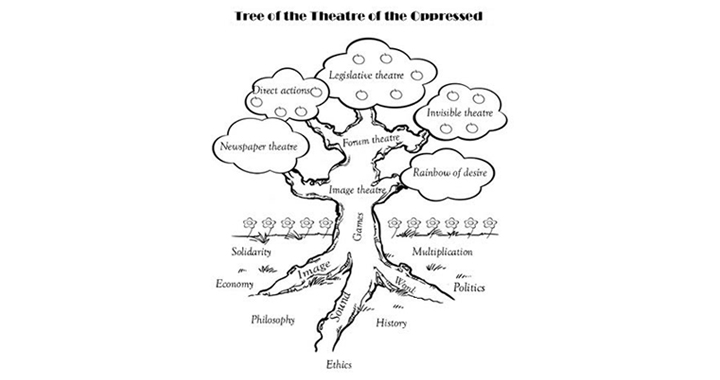Theatre of the Oppressed is a theatrical practice created by Brazilian theatre visionary, Augusto Boal, that uses roleplaying and improvisation to engage community members in identifying solutions to inequitable systems and institutions, and then translating those ideas into new laws. This method is now used worldwide for social and political activism, conflict resolution, community building, therapy, and government legislation.
Augusto Boal (1931-2009) developed the methodology of the Theatre of the Oppressed in the 1960s, inspired by Paulo Friere’s most famous book on the power of education, Pedagogy of the Oppressed. The socio-political context of the days in Brazil (post-colonialist era and authoritarian military junta regime) significantly influenced the development of these concepts, approaches and methodology.
The main features of Theatre of the Oppressed Methodology are:
- It is an interactive type of theatre – the audience engages actively, they can participate in the process and in some of the methods, they become “spect-actors”;
- It tackles real-life oppression in its various forms (the discussion on this topic is vast, as, very often, oppression can be interpreted in endless ways, and can be applied to almost all areas of life);
- It aims to bring along a change in relation to the specific oppression tackled – mostly by empowering the oppressed and the people around them.
Boal was first active in Brazil and experimented with theatre in order to give voice to the oppressed, to empower them to fight the oppression in their lives. Later, he was forced to leave the country, so he continued to work with these methods in other South American countries, and later in Europe.
The Theatre of the Oppressed comes in various forms. The main types of methods included under the Theatre of the Oppressed umbrella are:
- Forum Theatre;
- Image Theatre;
- Newspaper Theatre;
- Legislative Theatre;
- Invisible Theatre;
- Rainbow of Desire.

Probably one of the most known and widely used methods is the Legislative Theatre, which uses the forms of the Theatre of the Oppressed to transform citizens’ desires into laws. Through interactive theatre shows, community members act out solutions to situations of oppression and then work with officials to transform them into new laws or changes to existing laws. Since the method was first used in 1992, many groups have worked with Legislative Theatre and different approaches have emerged, based on different realities, contexts, relationships with authorities, etc.
The main advantages of the method are that it mobilizes groups of oppressed people who share similar obstacles, therefore making politics/policies accessible to people and enabling citizen mobilization for systemic change. Since it creates a space for direct interaction between citizens, decision-makers, and other affected parties, it helps to develop creative solutions for complex issues such as homelessness, inequitable justice systems, and workers’ rights. However, it is important to point out that the Legislative Theatre aims to change the system (its laws, structures, rules, methods, etc.) but, in practice, the extent to which the change happens depends on many other factors.
Wanna learn more about participatory methods for policy-making? Contact us via info@participationfactory.com
Sources:
https://www.peoplepowered.org/legislative-theater
https://dlibrary.stanford.edu/ambiguity/theatre-of-the-oppressed